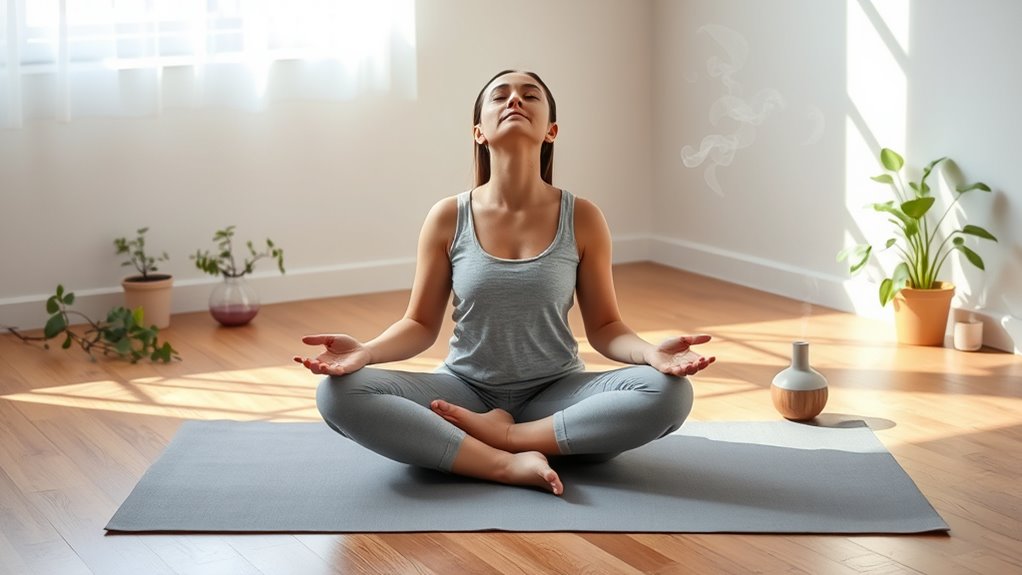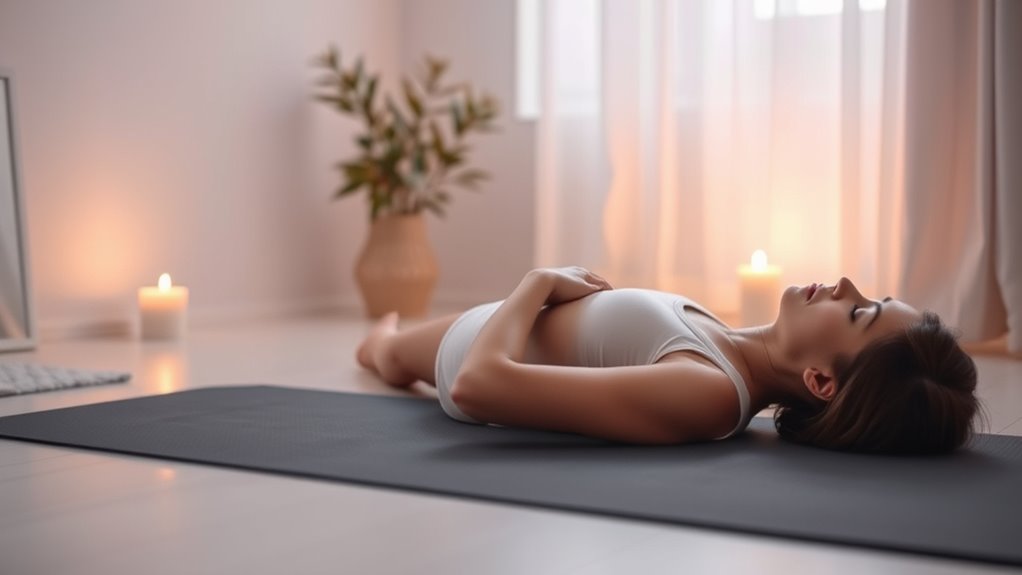To relax tight pelvic floor muscles, start by preparing your body with slow, gentle movements and sit or lie comfortably. Focus on diaphragmatic breathing—deep, slow breaths that help release tension. Apply heat therapy to the area to soothe stiffness. Incorporate mindfulness techniques like guided breathing or meditation to reduce stress-related clenching. Consistent practice fosters muscle flexibility and control. If symptoms persist, consider professional guidance. You’ll find more detailed steps and techniques to support pelvic floor health ahead.
Understanding the Pelvic Floor and Its Functions

Although the pelvic floor is often overlooked, it plays an essential role in supporting your pelvic organs and maintaining continence. Understanding pelvic anatomy helps you recognize that this complex muscle group forms a supportive hammock at your pelvis base. These muscles control critical functions such as bladder and bowel regulation, sexual health, and core stability. When your pelvic floor muscles function properly, they provide strength and flexibility, allowing you freedom in daily activities without discomfort or restriction. Recognizing how these muscle functions impact your overall well-being empowers you to address tightness effectively. By appreciating the pelvic floor’s role, you can better engage in targeted relaxation techniques, fostering improved muscle balance and enhancing your quality of life with confidence and ease.
Common Causes of Tight Pelvic Floor Muscles
When your pelvic floor muscles become tight, it’s often due to a combination of physical and emotional factors that place undue stress on this delicate muscle group. Recognizing these common causes can help you regain control and comfort. Tightness frequently stems from:
Pelvic floor tightness often arises from intertwined physical and emotional stresses affecting this sensitive muscle group.
- Muscle imbalances caused by poor posture, repetitive strain, or injury, which disrupt normal pelvic function.
- Chronic stress factors, including anxiety and emotional tension, that increase muscle guarding and reduce relaxation capacity.
- Overuse or excessive contraction during activities like heavy lifting or high-impact exercise, leading to constant muscle tension.
Understanding these root causes empowers you to address tightness effectively, easing restrictions and restoring freedom to your pelvic floor muscles.
Signs and Symptoms of Pelvic Floor Tension

If you’re experiencing pelvic floor tension, you might notice a range of signs that indicate your muscles are overly tight or not functioning properly. Common symptoms include pelvic pain and muscle stiffness, which can limit your comfort and mobility during physical activity. You may also experience urinary urgency or difficulty fully emptying your bladder. Sexual dysfunction, such as pain during intercourse or reduced sensation, can be another indicator of pelvic floor tension. Emotional stress often accompanies these symptoms, creating a cycle that worsens muscle tightness. Recognizing these signs early is essential for regaining control and freedom in your body. Understanding your symptoms empowers you to seek appropriate strategies to relax your pelvic floor muscles and restore balance to your daily life.
Preparing Your Body and Mind for Relaxation
Before you begin relaxing your pelvic floor muscles, it’s important to prepare both your body and mind. Start with mindful breathing techniques to calm your nervous system and increase oxygen flow. Then, engage in a gentle body warm-up to reduce muscle tension and enhance awareness.
Mindful Breathing Techniques
Although it may seem simple, mindful breathing is a foundational technique that helps you prepare both your body and mind for relaxing tight pelvic floor muscles. Focusing on breath awareness allows you to release tension gradually, facilitating a state of calm and readiness. Diaphragmatic breathing, in particular, encourages full oxygen exchange and activates the parasympathetic nervous system, promoting muscle relaxation.
To practice mindful breathing effectively, focus on:
- Observing the natural rhythm of your breath without judgment.
- Engaging the diaphragm by allowing your abdomen to rise and fall gently.
- Maintaining slow, even breaths to reduce sympathetic nervous system activity.
Gentle Body Warm-up
Since your body and mind are closely connected, starting with a gentle warm-up can ease the shift into deeper relaxation of your pelvic floor muscles. Begin by engaging in slow, gentle movements that awaken your body without strain. Simple actions like pelvic tilts, hip circles, or gentle stretching cultivate body awareness, allowing you to tune into areas of tension. As you move, focus on the sensations within your pelvis and surrounding muscles, encouraging a mindful connection. This mindful body awareness primes your nervous system for relaxation, reducing protective muscle tightness. Remember, the goal is softness and ease—not force. By preparing your body gently, you foster an environment where your pelvic floor can release tension naturally, supporting your journey toward freedom from discomfort and increased muscular ease.
Breathing Techniques to Release Pelvic Floor Tightness

When you focus on your breath, you can directly influence the tension in your pelvic floor muscles. Diaphragmatic breathing encourages abdominal expansion, which gently stretches and relaxes the pelvic floor. By consciously slowing your breath and deepening inhalations, you create a calming effect that reduces muscle tightness.
To practice effectively:
- Inhale deeply through your nose, allowing your abdomen to rise without chest movement.
- Exhale slowly through your mouth, visualizing your pelvic floor releasing tension.
- Repeat this cycle for 5–10 minutes, maintaining awareness of abdominal expansion and pelvic relaxation.
This technique fosters a mindful connection between breath and pelvic floor, helping you regain control and freedom from discomfort. Regular practice can greatly ease tightness and promote lasting relaxation.
Gentle Pelvic Floor Stretches to Try at Home
Building on breath awareness, incorporating gentle stretches can further ease tension in your pelvic floor muscles. Start with simple yoga poses like Child’s Pose or Happy Baby, which promote relaxation and lengthening of these muscles. Flexibility exercises such as pelvic tilts and seated forward bends gently engage and release tightness without overstressing the area. Focus on slow, controlled movements paired with deep, diaphragmatic breathing to maximize muscle relaxation. Avoid forcing any stretch; instead, listen to your body’s signals to prevent discomfort. Consistent practice of these targeted stretches at home fosters increased mobility and helps restore your pelvic floor’s natural flexibility. By integrating these techniques into your routine, you empower yourself with freedom from tightness and support overall pelvic health.
Using Heat Therapy for Muscle Relaxation
Although gentle stretches help release pelvic floor tension, applying heat therapy can further enhance muscle relaxation by increasing blood flow and reducing stiffness. Heat application targets the affected muscles, promoting tissue elasticity and easing discomfort. You can use warm compresses to deliver controlled warmth directly to the pelvic area, facilitating a calming effect on tight muscles.
To maximize benefits, consider these guidelines:
- Apply warm compresses for 15-20 minutes, ensuring the temperature is comfortable to avoid burns.
- Use heat therapy regularly, especially before stretching or physical activity, to prepare muscles.
- Combine heat application with proper hydration to support muscle recovery.
This approach supports your body’s natural ability to regain flexibility and comfort, helping you move freely without persistent pelvic tension.
Incorporating Mindfulness and Meditation Practices
You can enhance pelvic floor relaxation by incorporating mindfulness and meditation into your routine. These practices help reduce muscle tension by promoting focused awareness and calming your nervous system. Using guided meditation techniques and establishing daily relaxation rituals can support sustained relief and improve your overall well-being.
Benefits of Mindfulness
When you practice mindfulness and meditation regularly, you create a mental space that helps reduce the tension in your pelvic floor muscles. This intentional awareness supports your body’s natural relaxation processes and fosters a sense of freedom from chronic tightness. Mindfulness enhances your ability to monitor and respond to subtle bodily cues, which is essential for pelvic health.
The benefits include:
- Improved stress reduction, lowering muscle clenching caused by anxiety.
- Enhanced mindful eating habits, promoting better digestion and reducing pelvic discomfort.
- Increased body awareness, allowing you to consciously release unnecessary pelvic floor tension.
Guided Meditation Techniques
Since tight pelvic floor muscles often result from chronic stress and unconscious tension, guided meditation techniques can be an effective tool to promote relaxation and awareness. Using guided imagery or a body scan, you can systematically release muscle tightness and reconnect with your body’s sensations. These practices foster a mindful presence, allowing you to identify and soften areas of tension.
| Technique | Focus Area | Benefit |
|---|---|---|
| Guided Imagery | Visualizing calmness | Eases muscle tension |
| Body Scan | Systematic body check | Enhances body awareness |
| Breath Awareness | Deep, slow breathing | Reduces stress response |
| Progressive Relaxation | Muscle group release | Promotes deep muscular relaxation |
Daily Relaxation Rituals
Although tight pelvic floor muscles can be challenging to manage, incorporating daily relaxation rituals that combine mindfulness and meditation can greatly ease tension over time. By embedding these self care practices into your routine, you actively promote muscle release and mental calmness, essential for lasting relief. Consider these relaxation techniques to support your journey:
- Begin each day with a 5-minute mindfulness breathing exercise, focusing on slow, deep breaths to reduce muscle tightness.
- Set a consistent time for guided meditation that emphasizes body scanning, helping you identify and relax pelvic floor tension.
- Incorporate gentle stretching combined with focused awareness to reconnect with your pelvic muscles and encourage release.
These deliberate, daily practices empower you with freedom from discomfort, fostering both physical and emotional well-being.
When to Seek Professional Help for Pelvic Floor Issues
How do you know if your pelvic floor issues require professional evaluation? If you experience persistent pelvic pain, discomfort during daily activities, or difficulty controlling bladder or bowel functions, it’s vital to seek professional evaluation promptly. These symptoms may indicate underlying dysfunction that simple self-care can’t resolve. Additionally, if relaxation techniques fail to improve your symptoms after several weeks, or if you notice worsening pain or new symptoms like numbness, professional guidance becomes essential. A trained specialist can accurately diagnose the cause, tailor treatment, and help restore your pelvic floor’s function, granting you the freedom you deserve. Don’t hesitate to reach out; early intervention often leads to better outcomes and improved quality of life. Your comfort and well-being matter.
Creating a Daily Routine to Maintain Pelvic Floor Health
To maintain pelvic floor health effectively, you need a consistent daily routine that incorporates targeted exercises and mindful habits. Establishing this routine supports muscle flexibility, strength, and relaxation, giving you greater control and freedom in daily life.
Focus on these key elements:
- Incorporate daily exercises such as gentle stretches and controlled contractions to enhance muscle responsiveness.
- Prioritize hydration importance by drinking adequate water, which helps maintain tissue elasticity and overall pelvic health.
- Practice mindful breathing techniques to reduce tension and promote relaxation in the pelvic region.




